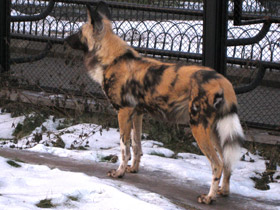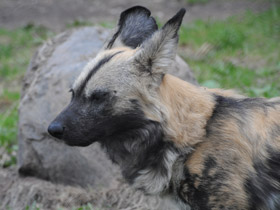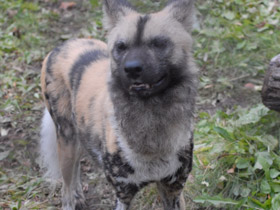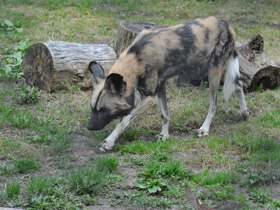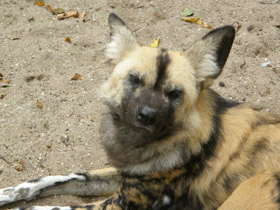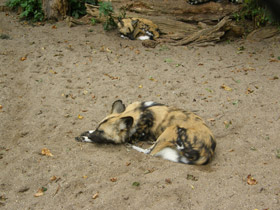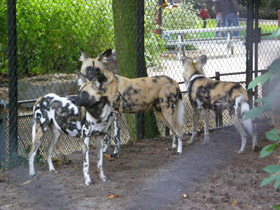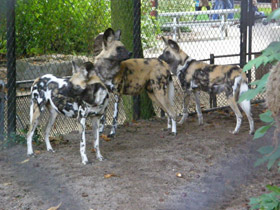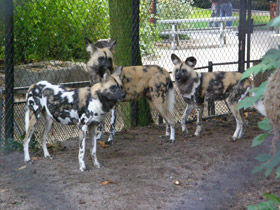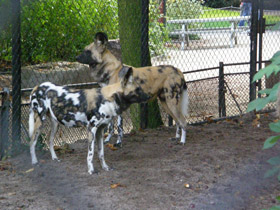The African wild dog, the painted dog or Cape hunting dog (Lycaon pictus)
The African wild dog (Lycaon pictus), also known as the painted dog or Cape hunting dog, is a wild canine native to sub-Saharan Africa. It is the largest wild canine in Africa, and the only extant member of the genus Lycaon, which is distinguished from Canis by dentition highly specialised for a hypercarnivorous diet and by a lack of dewclaws.
It is estimated that there are around 6,600 adults (including 1,400 mature individuals) living in 39 subpopulations, all threatened by habitat fragmentation, human persecution and outbreaks of disease. As the largest subpopulation probably consists of fewer than 250 individuals, the African wild dog has been listed as endangered on the IUCN Red List since 1990.
The species is a specialised diurnal hunter of terrestrial ungulates, which it captures by using its stamina and cooperative hunting to exhaust them. Its natural competitors are lions and spotted hyenas: the former will kill the dogs where possible whilst the latter are frequent kleptoparasites. Like other canids, the African wild dog regurgitates food for its young but also extends this action to adults as a central part of the pack's social unit. The young have the privilege of feeding first on carcasses.
The African wild dog has been respected in several hunter-gatherer societies, particularly those of the San people and Prehistoric Egypt.
Etymology and naming
The English language has several names for the African wild dog, including African hunting dog, Cape hunting dog, painted hunting dog, painted dog, painted wolf, and painted lycaon. Though the name African wild dog is widely used, ‘wild dog’ is thought by conservation groups to have negative connotations that could be detrimental to its image; one organisation promotes the name ‘painted wolf’, whilst the name ‘painted dog’ has been found to be the most likely to counteract negative perceptions.
Taxonomy
The earliest written reference for the species appears to be from Oppian, who wrote of the thoa, a hybrid between the wolf and leopard, which resembles the former in shape and the latter in colour. Solinus's Collea rerum memorabilium from the third century AD describes a multicoloured wolf-like animal with a mane native to Ethiopia.
The African wild dog was scientifically described in 1820 by Coenraad Jacob Temminck after examining a specimen from the coast of Mozambique. He named the animal Hyaena picta, erroneously classifying it as a species of hyena. It was later recognised as a canid by Joshua Brookes in 1827 and renamed Lycaon tricolor. The root word of Lycaon is the Greek λυκαίος (lykaios), meaning ‘wolf-like’. The specific epithet pictus (Latin for ‘painted’), which derived from the original picta, was later returned to it, in conformity with the International Rules on Taxonomic Nomenclature.
Paleontologist George G. Simpson placed the African wild dog, the dhole and the bush dog together in the subfamily Simocyoninae on the basis of all three species having similarly trenchant carnassials. This grouping was disputed by Juliet Clutton-Brock, who argued that other than dentition too many differences exist among the three species to warrant classifying them in a single subfamily.
Description and appearance
Lycaon pictus is a slender, stocky animal with a slender, slender body, long, strong legs and a relatively long, fluffy tail. It is an extremely carnivorous predator with a relatively short mouth and powerful teeth for gnawing and crushing bones. The large, rounded ears help to cool the body and indicate the extraordinary importance of sound signals in social contacts (photo 3).
The coat of the Lycaon pictus is thick, short, rather sparse and of a peculiar colour. This parakeet species is characterised by an unusual bright patchy colouring, which is a combination of white, black and brownish-yellow. Interestingly, each specimen is unique: some dogs are white, while others are black; these colours form a basic background with darker and lighter patches. The pattern of spots is asymmetrical, very irregular in shape, size and colour (photo 1 and 2).
Social behaviour
Lycaon pictus is probably the most social of all hounds. They are always kept in packs, with an average of 7-8 adult animals, but sometimes there are packs of 30 or even 50 dogs. Only the dominant pair breeds in a pack, the other dogs help to get food and feed their puppies.
Hunting and feeding
There is a clear division of labour within the pack: when a pack goes hunting, for example, some dogs stay with the puppies. On returning from a successful hunt, the well-fed animals regurgitate some of their meat to those who have not been on the hunt. Like all social animals, different forms of communication are very important for hyena dogs. Every hunt is preceded by an obligatory ritual greeting ceremony: all members of the pack moan happily, run excitedly, wag their tails, lick each other's faces and beg for food.
These animals stalk and slaughter large numbers of ungulates and hardly eat any food other than fresh meat. Their main prey are medium-sized antelopes such as impala, kudu or Thomson's gazelle. They sometimes hunt larger ungulates, such as canna antelope, chamois and buffalo, but if there is a shortage of suitable food, they also hunt cane rats, hares and even lizards. When hunting collectively, they show an exceptional degree of coordination and can chase their prey at speeds of up to 60 km/h.
Threats and conservation
The African wild dog is primarily threatened by habitat fragmentation, which results to human-wildlife conflict, transmission of infectious diseases and high mortality rates. Surveys in the Central African Republic's Chinko area revealed that the African wild dog population decreased from 160 individuals in 2012 to 26 individuals in 2017. At the same time, transhumant pastoralists from the border area with Sudan moved in the area with their livestock.
The African Wild Dog Conservancy, a non-profit, 501(c)(3), non-governmental organisation, began working in 2003 to conserve the African wild dog in northeastern and coastal Kenya, a convergence zone of two biodiversity hotspots. This area largely consists of community lands inhabited by pastoralists. With the help of local people, a pilot study was launched confirming the presence of a population of wild dogs largely unknown to conservationists. Over the next 16 years, local ecological knowledge revealed this area to be a significant refuge for wild dogs and an important wildlife corridor connecting Kenya's Tsavo National Parks with the Horn of Africa in an increasingly human-dominated landscape. This project has been identified as a wild dog conservation priority by the IUCN/SSC Canid Specialist Group.
Subspecies
Since 2005 Mammal Species of the World (MSW) recognise the following subspecies:
Lycaon pictus lupinus (Thomas, 1902) - This subspecies is distinguished by its very dark coat with very little yellow.
Lycaon pictus manguensis (Matschie, 1915) - The West African wild dog used to be widespread from western to central Africa, from Senegal to Nigeria. Now only two subpopulations survive: one in the Niokolo-Koba National Park of Senegal and the other in the W National Park of Benin, Burkina Faso and Niger. It is estimated that 70 adult individuals are left in the wild.
Lycaon pictus pictus (Temminck, 1820) - The nominate subspecies is also the largest, weighing 20–25 kg (44–55 lb). It is much more colourful than the East African wild dog, although even within this single subspecies there are geographic variations in coat colour: specimens inhabiting the Cape are characterised by the large amount of orange-yellow fur overlapping the black, the partially yellow backs of the ears, the mostly yellow underparts and a number of whitish hairs on the throat mane. Those in Mozambique are distinguished by the almost equal development of yellow and black on both the upper and underparts of the body, as well as having less white fur than the Cape form.
Lycaon pictus sharicus (Thomas & Wroughton, 1907) - Brightly coloured with very short 15 mm (0.6 in) hair. Brain case is fuller than L. p. pictus.
Lycaon pictus somalicus (Thomas, 1904) - This subspecies is smaller than the East African wild dog, has shorter and coarser fur and has a weaker dentition. Its colour closely approaches that of the Cape wild dog, with the yellow parts being buff.
Although the species is genetically diverse, these subspecific designations are not universally accepted. East African and Southern African wild dog populations were once thought to be genetically distinct, based on a small number of samples. More recent studies with a larger number of samples showed that extensive intermixing has occurred between East African and Southern African populations in the past. Some unique nuclear and mitochondrial alleles are found in Southern
African and northeastern African populations, with a transition zone encompassing Botswana, Zimbabwe and southeastern Tanzania between the two. The West African wild dog population may possess a unique haplotype, thus possibly constituting a truly distinct subspecies. The original Serengeti and Maasai Mara population of painted dogs is known to have possessed a unique genotype, but these genotypes may be extinct.
IUCN conducted an assessment in 2012 on a specific population of African wild dogs in North Africa:
North African Lycaon: This is a possible extinct or extremely rare subspecies of Lycaon pictus in North Africa. The remaining populations may be of high conservation value, as they are likely to be genetically distinct from other populations of L. pictus. The only countries in North Africa where African wild dogs may still persist are Algeria and Chad, but there is no information on their current status. If they do persist, there seems little doubt that the total size of the subpopulation does not exceed fifty mature individuals. It is probably extinct in Mali and Nigeria, and is extinct in Egypt, Libya, Mauritania and Sudan. The IUCN classifies this population as Critically Endangered. Specimens from Tanezrouft, Algeria, were reported as a subspecies of North African Lycaon, although it is possibly applicable to the subspecies Lycaon pictus sharicus.
However, although the species is genetically diverse, these specific designations are not universally accepted. It was once thought that the wild dog populations of eastern and southern Africa were genetically distinct, based on a small number of samples. More recent studies with larger numbers of samples showed that extensive admixture has occurred in the past between East African and Southern African populations. Some unique nuclear and mitochondrial alleles are found in southern African and northeast African populations, with a transition zone encompassing Botswana, Zimbabwe and southeastern Tanzania in between. The West African wild dog population may possess a unique haplotype, possibly constituting a truly distinct subspecies.










